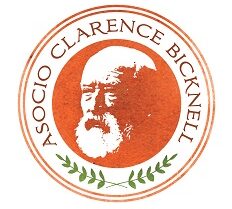NEWS – Edward Berry conference, Bordighera, 1 June 2013. .Just back from the conference about my great grand unce Edward Elhanan Berry (1861-1931) and his wife Margaret in the Museo Clarence Bicknell, presided by Professor Dott. Daniela Gandolfi. Read more…. https://clarencebicknell.com/en/news-views/25-news-bordighera-1june2013.html https://clarencebicknell.com/en/news-views/100-ellen-willmott.html alternative paths without “en” https://clarencebicknell.com/news-views/100-ellen-willmott.html https://clarencebicknell.com/news-views/25-news-bordighera-1june2013.html
Our assumption has been that the well-known photo of Bicknell and Pelloux together was taken in the high mountains, maybe in the Mercantour above the Vallée des Merveilles and Casterino. Not a bit of it; the gentlemen are taking an afternoon stroll and are low in the heat of the Italian Riviera, just a couple
Photo research: Alberto Pelloux and Clarence Bicknell Read More »
We are pleased to be able to publish this interesting paper by my cousin Ian Fraser. David Roberts was his great great great great grandfather ands his daughter Christine (1821-1872) married Henry Sanford Bicknell (1818-1880) who like his father Ehanan loved collecting art. Ian recovered Roberts’ lost journal of 1851-1860 from among his father’s papers
David Roberts and the Royal Academy, by Ian Fraser Read More »
Luca Barale writes “I have also find out that Clarence sent a collection of Pliocene fossils collected in the Bordighera neighbourhood to Federico Sacco, geologist and palaeontologist based in Torino, who studied them and published them in the huge, 30-volumes work “I Molluschi dei Terreni Terziarii del Piemonte e della Liguria”. Sacco also dedicated a
Clarence’s collection of Pliocene fossils Read More »
POEMS Clarence Bicknell’s principal works of poetry are in Esperanto; in fact there are no serious poems in English in the museums referred to on this site nor in the family collection. Some doggerel illuminates some of the work for children or for Margaret Berry, but they are hardly poems. Clarence’s poems in Esperanto, like
HYMNS It would seem evident at first glance that Clarence Bicknell, man of the church, would gravitate naturally towards writing hymns as a means of expression. However, as early as 1876 when Clarence was only 34 he began to have serious religious doubts. By 1880, within a year of settling in Bordighera, on the Italian
ESPERANTO Clarence Bicknell learned Esperanto in 1897, having previously studied Volapuk which enjoyed some success as a planned international language before being largely superseded by Esperanto. Bicknell must have started writing Esperanto around 1900 because his piece “La Piemonta Valo Pesio” (The Piedmont Pesio Valley) appeared in the collection Esperantaj Prozajo (Pieces of Esperanto Prose)
Clarence Bicknell, archaeologist. An appreciation, by Christopher Chippindale. In 1909, the senior French prehistorian Cartailhac paid Bicknell a visit. He was greatly interested by his long day’s excursion into the Val Fontanalba. The rocks were much more wonderful than he had expected; and he said. “It is a great mystery.” His antiquarian colleagues had previously
The Vallée des Merveilles, also known in Italian as the Valle delle Meraviglie (Valley of Marvels), is a part of the Mercantour National Park in southern France. It means “the valley of marvels” but most English-speakers use the name in French. The mountainous area, including the valleys of Meraviglie and Fontanalba, together with the towns
Clarence did not regard himself as an archaeologist. When he first went up into the Mercantour region in 1881, he certainly knew about the rock engravings but his main motive was to extend his botanical studies from the Mediterranean plants round Bordighera to include alpine specimens. He was to use the same painstaking and meticulous


